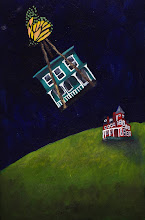



 Bouler Architecture recently submitted the Verace project as an entry in the AIA's restaurant competition. As part of the submission, James to put together a comprehensive overview of the green features in the project.
Bouler Architecture recently submitted the Verace project as an entry in the AIA's restaurant competition. As part of the submission, James to put together a comprehensive overview of the green features in the project.1. First and foremost, the re-use and re-commission of an older and abandoned existing building. The planning department of the local building department was very keen on keep the old building intact. It has been many uses: an office, a mixed use (retail and apartment) and a gift shop. The exterior facade was repaired as necessary, with very little changing on the exterior.
2. The wood floors and stairs are reclaimed wood.
3. Rather that powder coat the pizza and bread oven, we used light gauge steel and let it rust. It eliminated the need to toxic kynar powder coated finish over aluminum, which would need to be repainted every so often.
4. The wine is from a Eco-Keg. It holds 25 bottles of wine and keeps it fresh. It eliminates the need for all of the glass bottles and wine waste.
5. The water filtration system and re-usable carbonated glass container eliminated the use of many, many bottles of water.
6. The kitchen is part of the atmosphere with an open design. The heat that is normally wasted from the ovens, and cooking is keep in the building.
The exhaust fans are variable speed and can be controlled to keep as much heat in as possible in the winter and eliminate the heat in the summer. The HVAC system was designed to take this into account, so less energy is used
to heat the restaurant in the winter.
7. The bricks used on the exterior patios are reclaimed brick.
8. The mahogany windows, Unilux, uses sustainable forests, or FSC certified mahogany on their windows.
9. The windows are super insulated and are some the best performing for heat loss of gain in the industry.
10. The existing building envelope was super-insulated for optimum performance.
11. With the open kitchen plan we were able to have smaller footprint of the same number of seat of a larger restaurant. Smaller footprint, less energy used.
12. Verace is not using table linens, eliminating the energy and water need to washing and drying.



















